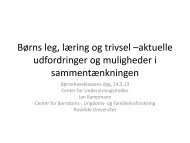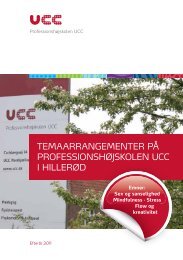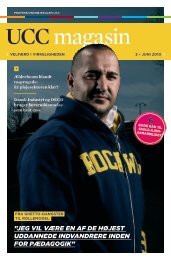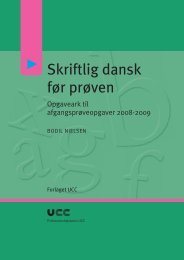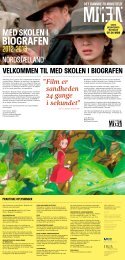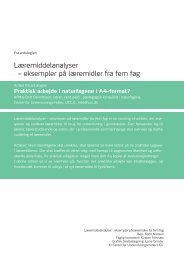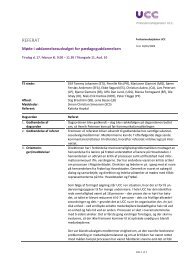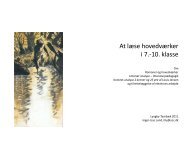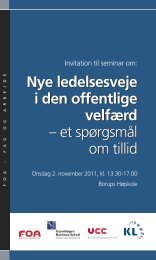AGORA - tidsskrift for forskning, udvikling og idéudveksling i ...
AGORA - tidsskrift for forskning, udvikling og idéudveksling i ...
AGORA - tidsskrift for forskning, udvikling og idéudveksling i ...
You also want an ePaper? Increase the reach of your titles
YUMPU automatically turns print PDFs into web optimized ePapers that Google loves.
<strong>AGORA</strong> - <strong>tidsskrift</strong> <strong>for</strong> <strong>for</strong>skning,<br />
<strong>udvikling</strong> <strong>og</strong> <strong>idéudveksling</strong> i professioner<br />
understanding or a solution. There<strong>for</strong>e it is beneficial and more productive to focus on our intentional<br />
relation to the environment, which also is <strong>for</strong>ward-oriented. Here the statement could be as follows: I<br />
will do this in order to reach that. As described earlier, this “in order to” is based in our pre-reflective<br />
and embodied intentional directedness on the one hand and/or on an investigation of af<strong>for</strong>dances in the<br />
environment on the other. Two strategies – which can easily merge with each other – are valuable to<br />
strengthen the intentional orientation of the individual towards specific environmental conditions:<br />
• Becoming aware of the embodied intentional dial<strong>og</strong>ue<br />
Our embodied intentional relationship to a specific environment and task is normally pre-reflective and<br />
based on implicit knowledge. But, in situations where we intend to improve a skill or technique, it seems<br />
to be beneficial to “intensify” this dial<strong>og</strong>ue. This process can be initiated by being aware of what actually<br />
happens in the situation – without being judgemental. This procedure has similarities with attention<br />
training which has been described further above. Now we could go a step further: We want not only to be<br />
attentive to what is happening – this would be the first step of the exercise, but, furthermore we want to<br />
gain a better understanding of how we can deepen our dial<strong>og</strong>ue with the situation and thus improve our<br />
skill or technique. In this situation, it is beneficial to be supported by a coach or partner.<br />
Working with intentional orientation will be illustrated with an example from soccer: The skill we would<br />
like to improve is to control the ball when receiving it from another player. In the first part of this exercise<br />
the two partners shoot the ball back and <strong>for</strong>th. Their attention is inward without being judgemental,<br />
and by focusing on one question at a time: What am I doing with my free leg? How do I approach the<br />
ball with my whole body? How do I approach the ball with my playing leg? What do I do with my<br />
hands? What do I do with my upper body when receiving the ball? What do I do with my breathing?<br />
In the second part of the exercise, the task is to reflect on the experiences with the partner: What did I<br />
(my partner, respectively) become aware of in the different exercise? In which situation did I have full<br />
control of the ball? What did I do precisely in this situation? When I think about experts, what do they<br />
do in similar situation? What is the intention behind their way of doing? – The dial<strong>og</strong>ue should integrate<br />
attentive experiences and relate these experiences to possible intentions by asking: What can I do when<br />
receiving the ball in order to…? Here it is always important to anticipate a future situation (e.g., being<br />
approached by an opponent just a second after receiving the ball).<br />
• Relating to af<strong>for</strong>dances in the environment<br />
Af<strong>for</strong>dances are possibilities in the environment which the individual sees and evaluates as “invitations”<br />
to act upon. Relating to af<strong>for</strong>dances and acting on the basis of them is, <strong>for</strong> example, essential in training<br />
<strong>for</strong> cooperation in ball games. In normal ball games, the player is confronted with complex situations. To<br />
read this complexity, e.g., delivering the ball through a defence row of opponents is based on relating to<br />
specific af<strong>for</strong>dances in the situation and on acting according to these af<strong>for</strong>dances. A coach can support the<br />
players’ ability to relate to af<strong>for</strong>dance by starting out with simple and less complex game situation in the<br />
beginning of the training and later on by continuing to arrange more complex situations when the players<br />
are ready to act on af<strong>for</strong>dances in more complex situations. For this training to be of value, it is important<br />
to have a dial<strong>og</strong>ue with the players on how they see and understand the situation, and in which way they<br />
intend to act upon it. In that sense, players’ actions are grounded on intentions which build on a clear and<br />
action-oriented understanding of the situation.<br />
Forming and developing narratives<br />
Many working and learning situations tie t<strong>og</strong>ether a bodily involvement of the individual with a<br />
community orientation, like, <strong>for</strong> example, in craft, physiotherapy, nursing, theatre, surgery, and sports.<br />
Situated action in these areas can be understood as a community of (embodied) practice, which – as<br />
Wenger (1998) describes – is based on joint enterprise, mutual engagement and a shared repertoire.<br />
To shape and improve the community of practice means building up common narratives on the basis of<br />
www.cvustork.dk/agora/ 19





